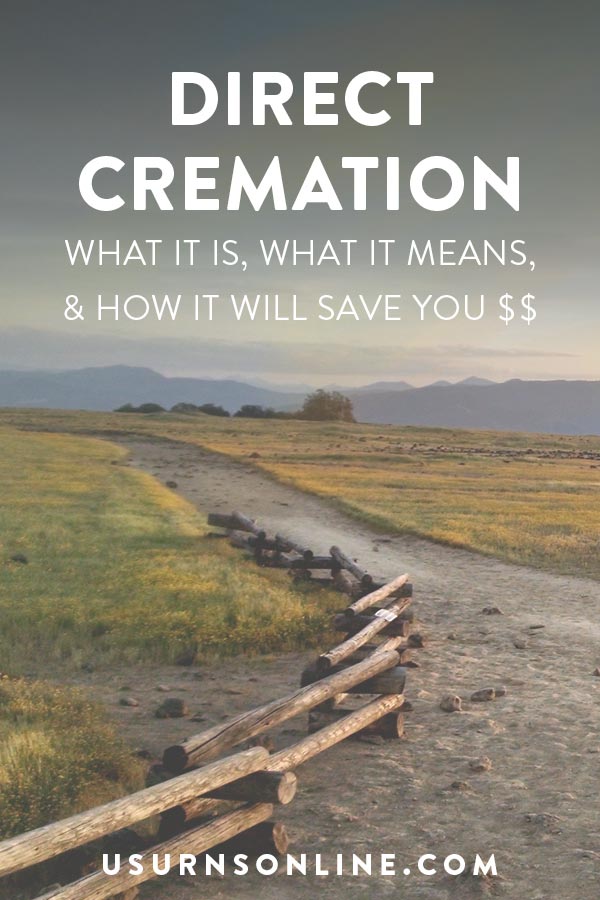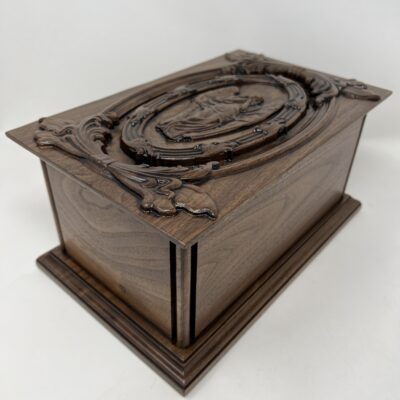Q: What is direct cremation?
A: Direct cremation means that the body of the deceased is cremated after death, without a prior memorial service and without the involvement of a funeral home.
Direct cremation is the most affordable disposition option that is readily available. Most funeral homes and crematoriums offer this service.
In this article, we’ll discuss the details, costs, options, and advantages/disadvantages of this service.
Why Choose Direct Cremation?
When you choose direct cremation as the disposition method for yourself or your loved one after death, the body is taken directly from the place of death to the crematorium without any additional stops.
This means that direct cremation is cheaper than most other options (since it does not involve the services of a funeral home) and in many ways simpler.
Costs
The method of direct cremation minimizes many of the costs traditionally associated with funerals by simply skipping them. Here are some of the costs avoided with direct cremation:
- Casket (the body is placed in a low-cost cardboard casket for cremation)
- Embalming / body preparation
- Funeral service costs
- Visitation costs
- Additional transportation
- The “basic services” funeral home fee
Below we provide some real quotes for direct cremation services for the Southern California areas in and around Los Angeles, and are fairly typical of the price range you will see in your area:
We gathered the quotes from each website and verified that they are valid as of the original posting date. Prices will likely change over time.
- Omega Society: $725 + transportation costs
- Accord Cremation and Burial: Starting at $755
- Armstrong Mortuary: $995 total
- All California Cremation: $795 + state fees & temporary urn cost
- SoCal Cremations: $748 total
- Coast Cities Cremation: $1195 total
- Alpha Society: $795 total
Many funeral homes have their own crematoriums, and you can often get direct cremation services done through a funeral home. In these cases costs may be just slightly higher than working with an independent crematorium, but it can also be worth it to have the assurance and professionalism provided by going through a funeral home.
Urns Made in the USA
Memorial Service Options
Since there will not be a funeral or other service before the cremation, families are free to schedule the memorial service at the time and place that best suits them.
You can choose to have the cremated remains at the service in a cremation urn, or not. Here are some options for memorial services after direct cremation:
- The family’s church
- A local community center
- The deceased’s club/lodge/etc
- In the home of a family member or friend
- Anywhere that rents space for weddings or funerals
- At a cemetery when the remains are buried
- At the beach when the remains are scattered
- On a boat when the remains are scattered at sea
Disposition Options
After the cremation is complete, you will receive the remains from the crematorium in a plastic bag which will be inside a plastic or cardboard “temporary urn.”
You can keep the remains in the temporary urn (don’t be fooled by the name, it will work just fine), or you can transfer the remains into a beautiful permanent memorial urn, or use a special scattering urn to assist in scattering.
We discuss the most common disposition options available to you in this article, and you can find inspiration for alternative methods – some that border on the bizarre – by checking out 27 Things to Do With Cremated Remains.
The classic, traditional disposition methods are these:
- Bury
- Store
- Keep
- Scatter
- Share
- Any combination of the above
Summary: Direct Cremation Pros & Cons
Pros:
- Affordable — the lowest cost option available
- Simple and minimal fuss
- Less decisions to make at the time of death
- Once the body is cremated, you have more options for memorials — you are not limited by concerns of body decomposition, as cremated ashes maintain their state
Cons:
- It happens quickly; while there is certainly time to “say goodbye” it’s not the same as having several days.
- Less hands-on; some families prefer to be more involved than direct cremation allows.
- Other arrangements can be made that are also budget-friendly.
- The family cannot witness/watch a direct cremation.
Here is some more helpful information as you consider this cremation option:
- The crematorium can take care of the death certificate.
- The crematorium can arrange transportation of the body (usually for a nominal fee).
- You will receive the remains in a plastic or cardboard box, generally called a “temporary urn.”
- You can bring your own urn; this may in some cases reduce the cost slightly by eliminating the temporary urn.
- Ask about fees and taxes; some crematoriums will include those in their quote, others will add them afterwards.
- Laws vary by state, but most require a waiting period of about 48 hours after death before the cremation can take place.
- Direct cremation can take 1-3 days, depending on how busy the crematorium is.
- The time it takes for the actual cremation is generally about 2-5 hours.
- Other factors will add to the time, such as removal of pacemakers and other medical devices, etc.
- You cannot witness a direct cremation.
Next Steps
- Contact funeral homes and crematoriums to compare prices and options
- Choose a cremation urn for your loved one’s remains
- Write down the information in your final arrangements documents or folder






I really like the simplicity of a direct cremation. My family doesn’t like the fanfare that traditional funerals tend to have, and would prefer a simpler method of memorial. Even if you don’t have private crematoriums to work with, you can probably find a funeral home that is willing to assist you with direct cremation.
Direct Cremation is one of the best and cheap services available
It’s interesting to know that direct cremation is cheaper than other options. My father is preplanning his funeral, and we are looking for options. I will let him read this article to help him understand what is direct cremation.
I’ve never heard of burying or sharing the ashes so I’m glad you brought it up. Why would you want to bury the urn instead of keeping it? My grandma wants to be cremated when she passes, so I’ll have to ask her what kind of method she’d like.
We provide low cost funerals and direct cremation in the UK, feel free to check us out.
We seem to visiting this blog a lot recently! Nice article Daniel, we enjoyed reading it. I think direct cremation is a little different in the UK in so far as there is still a need for a funeral home in most cases.
With regard to burying the urn Tori, many people buy biodegradable urns that are buried as a way of returning their loved one to the earth.
We provide low cost funerals and direct cremation in the UK, feel free to check us out.
We seem to visiting this blog a lot recently! Nice article Daniel, we enjoyed reading it. I think direct cremation is a little different in the UK in so far as there is still a need for a funeral home in most cases.
With regard to burying the urn Tori, many people buy biodegradable urns that are buried as a way of returning their loved one to the earth.
I am trying to find a flat head stone that already has a place to put your ashes in the stone. You place the ashes in an urn under the stone.
Terry, there is an option for an urn that can be used as a small headstone. This is an outdoor use urn, which there are not many. See the urn here: https://urnsnw.com/garden-stone-granite-urn-in-black/ If you bury it part way, it can sit like most flat headstones which are normally 4″ thick.